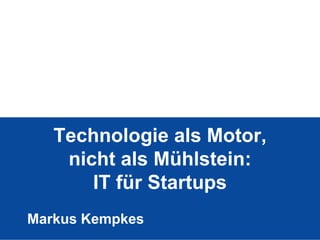Technologie als Motor, nicht als MĂŒhlstein it fĂŒr start-ups
- 1. Technologie als Motor, nicht als MĂŒhlstein: IT fĂŒr Startups Markus Kempkes
- 2. Wer ist das?
- 3. Map Business to IT Strategy What does Which are my markets / products / services / channels / partners? it mean Which are the capabilities / things / people I need to have to achieve this? How much resources / money / time do I have for this? Why is it It helps you to define the things you need to do in IT important? It helps you to prioritize: âbeauty vs. dutyâ It helps you to define limiting assumptions and boundaries How can I Series of workshops with or without external help / facilitation do it?
- 4. Application Strategy Which Applications do I need? What does What is the required / desired / nice-to-have functionality of the application? it mean What is the level of control and ownership, which I need? How much is this application related to my core business value / intellectual property? You understand what you need to do by yourself Why is it important? an outsourcing partner can develop for you a product supplier can sell you Define your business units / processes / functional requirements / features How can I do it? Try to get it in the Cloud for free or rented Try to buy a product If you canât buy it, try to outsource it If you canât outsource if, do it yourself
- 5. Infrastructure Strategy Which Infrastructure do I need? What does Which are my strategic platforms / languages / databases / integration technologies? it mean Can start small and cost effective (pay as you go) Can scale up and out as my business grows (1 to 10.000.000 users) Enterprise level support available (24x7, around the globe) Will be around in 10 years (solid vendor, market leader quadrant) Is supported by many suppliers (sufficient supply, hiring area, university supply) You will learn to thing big Why is it important? not transform your âhobby skillsâ or âpersonal tasteâ into your strategic platform choices layout the baseline for long growth avoid a very! painful learning curve and a business continuity risk Design for 20x capacity How can I Implement for 3x capacity do it? Deploy for ~1.5x capacity Choose mainstream, proven, solid vendors Choose IAAS / PAAS where ever possible
- 6. Starting 2-3 founders / 100⏠per month Intranet & Wiki 0,00⏠ALM / SCM / 8,00⏠Tools eMail & Database 0,00⏠18,50⏠Collaboration (5GB) Internet & eShop 12,00⏠19,90⏠Phone CRM CMS 10,00⏠32,40⏠(2 User, Group) Server Bring your Micro Edition, 1st 0,00⏠Notebook 0,00⏠year) own!
- 7. When the Business Angel rings twice Team of 10 / 800⏠per month Intranet & Wiki 72,50⏠ALM / SCM / 38,00⏠Tools eMail & Database included 229,00⏠Collaboration (MultiServer) Internet & eShop included Phone 45,00⏠(MultiServer) (VDSL50) CRM CMS included (3 User, 210,00⏠(MultiServer) Professional) Notebook Server included 180,00⏠(MultiServer) (10x600âŹ)
- 8. And the company is buzzing 50 employees / 7.500⏠per month Intranet & Wiki 950,00⏠ALM / SCM / 700,00⏠Tools eMail & Database included (6xMultiServer, 2 1.374,00⏠Collaboration Datacenter) Internet & eShop included Phone 135,00⏠(3xVDSL50) CRM (20 User, CMS included 2.800,00⏠Professional & Service) Notebook Server included 1.500,00⏠(50x1.000âŹ)
- 9. Staffing the DevTeam Domain of Expertise Employee Freelancer Local Partner Nearshore Partner Benefit Keep control Work on premise, some Work on premise, fix price Fix price packages, control, easy to replace packages, warranties warranties, joint ventures, lower cost Risk Not easy to find, not easy to Attrition, IP leakage Long-term commitment, Language and distance, replace price pressure learning curve Project Management Cost: 300-450⏠Cost: 700-900⏠Cost: 800-1000⏠Cost: 350-450⏠Solution Architecture Availability: Low Availability: Medium Availability: Low Availability: Very Low Web Design Software Development Donât do Cost: 300-500⏠Cost: 400-800⏠Cost: 150-250⏠Testing (only KEY developers) Availability: Medium Availabilty: High Availability: High Operations & Support
- 10. My 5 cents You donât choose plattforms, you choose ecosystems You prefer commodity over cutting edge technologies ... unless it gives you a competitive advantage You learn to partner and outsource right from the beginning Donât over-engineer!
- 11. Vielen Dank ... any questions?











